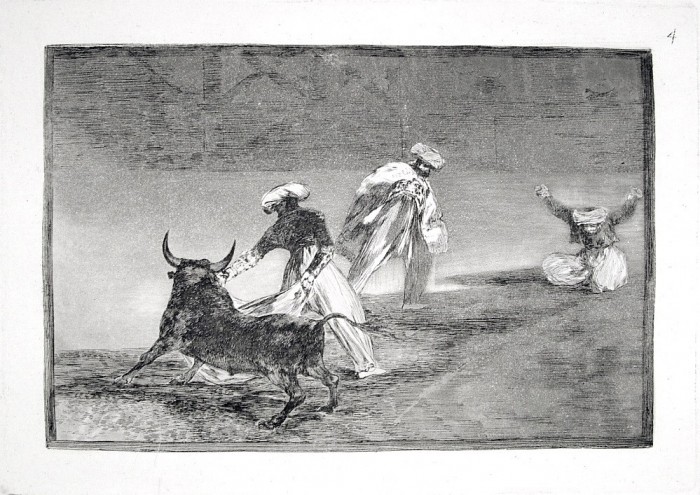Capean Otro Encerrado (They Play Another With the Cape in an Enclosure)

Francisco Goya (1746-1828), Capean Otro Encerrado (They Play Another With the Cape in an Enclosure), etching, burnished aquatint, drypoint and burin, 1814-16, Plate 4 of the Tauromaquia [with the number 4 upper right]. Reference: Harris 207, Delteil 227, First Edition (of 7). In very good condition apart from printer’s creases upper left and lower left, the full sheet with wide margins, 9 5/8 x 14, the sheet 12 1/2 x 17 1/4, archival window mounting.
A fine impression printed on the fine laid paper used for the First Edition impressions as indicated by Harris. The medium grain aquatint, in one tone, burnished on the left and in the middle around the figures contrasts well with the highlights of the figures. The scratch in the plate in an arc from the seated figure at the right to the bottom foreground occurred before the First Edition and is quite visible in fine impressions such as this example.
This edition is the only one in which the full qualities of the plates can be appreciated. The impressions are extremely fine and are all clean-wiped. (Only the First Edition impressions are lifetime; the six subsequent editions were posthumous).
This is the second of the Tauromaquia series in which Goya shows the Moors fighting. In the earlier print he noted that “The Moors settled in Spain, giving up the Koran, adopted this art of hunting.” Here, they “play” with a bull in an enclosure. Robert Hughes has noted that it’s historically untrue that the Moors were particularly interested in bullfighting, but suggests that Goya adopted this idea in order to portray bullfighters wearing the Mameluke uniforms he had seen Napoleon’s mercenaries wearing in Madrid – so these Moors were depicted as bullfighters because they were so colorful. Also, Hughes points out that the bulls in these aquatints were quite small, perhaps 400 pounds smaller than today’s huge bulls, which are specially bred for the ring.